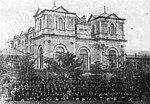National Diet Building
Art Deco architectureBuildings and structures in Chiyoda, TokyoFires at legislative buildingsGovernment buildings completed in 1936Government buildings in Japan ... and 5 more
Government buildings with domesGovernment of JapanNational DietSeats of national legislaturesUse American English from January 2022

The National Diet Building (国会議事堂, Kokkai-gijidō) is the building where both houses of the National Diet of Japan meet. It is located at Nagatachō 1-chome 7–1, Chiyoda, Tokyo. Sessions of the House of Representatives take place in the left wing and sessions of the House of Councillors in the right wing. The Diet Building was completed in 1936 and is constructed out of purely Japanese materials, with the exception of the stained glass, door locks, and pneumatic tube system.
Excerpt from the Wikipedia article National Diet Building (License: CC BY-SA 3.0, Authors, Images).National Diet Building
National Route 246, Chiyoda
Geographical coordinates (GPS) Address External links Nearby Places Show on map
Geographical coordinates (GPS)
| Latitude | Longitude |
|---|---|
| N 35.67571 ° | E 139.74481 ° |
Address
国会議事堂
National Route 246 1
100-0014 Chiyoda
Japan
Open on Google Maps








